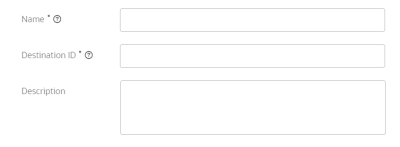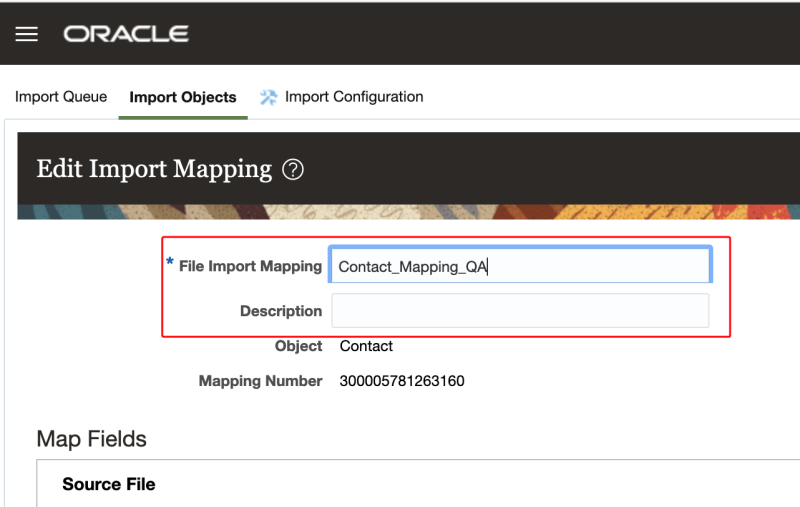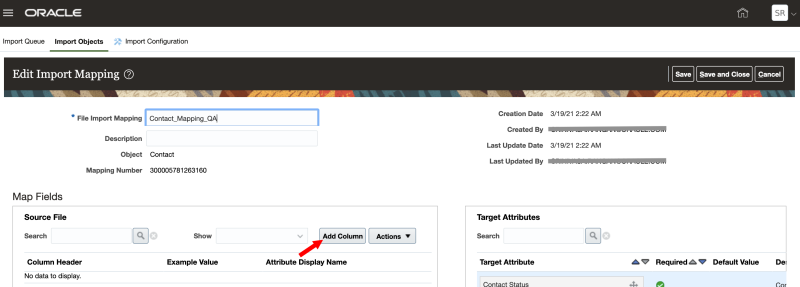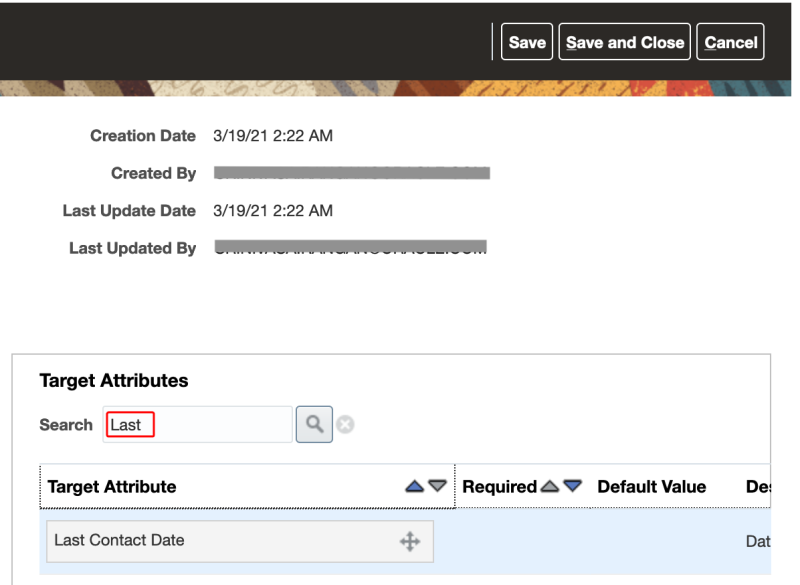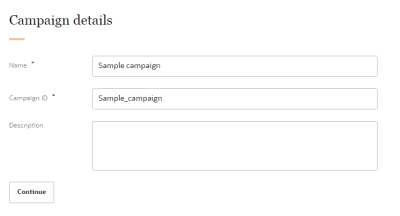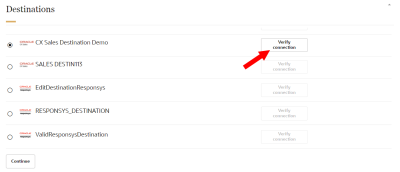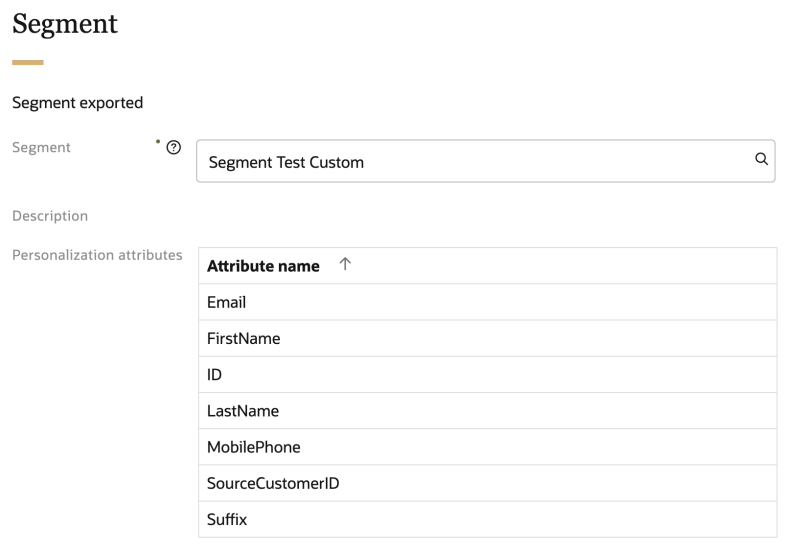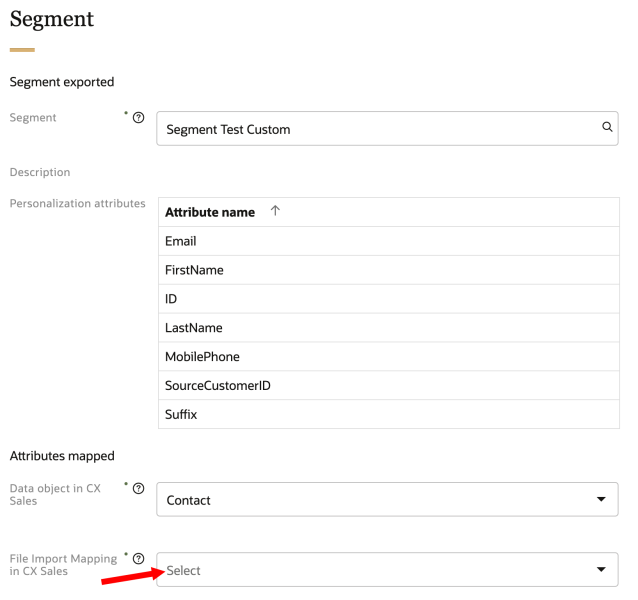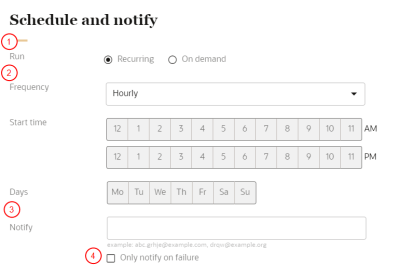Setting up the export of data to Oracle CX Sales
To export Oracle Unity segments to Oracle CX Sales, you will need to do the following.
If needed, review Oracle CX Sales troubleshooting tips for exporting data.
After running the CX Sales segment delivery, data will be imported automatically into CX Sales with the External Data Loader Client.
Learn more about the External Data Loader Client by reviewing the topic on Understanding Import and Export Management for CX Sales and B2B Service from the Oracle CX Sales Help Center.
Create a CX Sales destination
You will need to create the CX Sales destination to configure where the data will be exported to.
To create the CX Sales destination:
-
Click the Oracle icon
 in the bottom-right corner to open the navigation menu.
in the bottom-right corner to open the navigation menu.
- Select Destinations.
- In the top-right corner, click Create destination.
Step 1: Define destination details
The job details section allows you to define the type of destination and how it will display in Oracle Unity.
Enter the information for the destination.
- Type: Use the drop-down list to select CX Sales.
-
Name: Enter a name. The name must be 1 or more characters, up to a maximum of 50. Use only letters (a–z and A–Z), numbers (0–9), underscores (_), hyphens (-), and spaces. The first character cannot be a space.
-
Destination ID: The unique system identifier that is auto-populated from the destination name you enter. You can't change this value after you create the destination.
-
Description: Enter a description. This field is optional, but it is highly recommended to add descriptions for any entity created. This helps all other users get additional context when using and navigating Oracle Unity. The description can have a maximum of 512 characters with no restrictions on characters used. You can use characters from all languages supported in the language settings.
Step 2: Configure authentication settings
Enter the information to allow Oracle Unity to access the required data.
- URL: Enter the base URL for your CX Sales instance in this format: https://<CX Sales host name>.
- Username: Enter the username to access the URL.
- Password: Enter the password to access the URL.
Once you enter all the details, click Verify connection to ensure that Oracle Unity can access the destination.
If there are connection issues, ensure the base URL entered and login credentials are correct.
Field mapping section
Do not complete this section. Continue to: Step 3: Save and publish the new destination.
Field mapping between Oracle Unity personalization attributes and CX Sales attributes will be configured in the next task: Set up field mapping in CX Sales.
Step 3: Save and publish the new destination
When finished defining the destination, scroll to the top of the page and click Save or Save and close.
Once you create the destination, you will need to publish the changes.
Set up field mapping in CX Sales
After creating the segments you want to export and configuring the personalization attributes for the segments, you will have to map the Oracle Unity personalization attributes to CX Sales attributes.
-
You can create a master list of mappings in one file for multiple Oracle Unity segments to one CX Sales object. Each Oracle Unity segment delivery will use the appropriate mappings from this one mapping file.
-
You can map one Oracle Unity personalization attribute to multiple CX Sales attributes. For example, you can map the Email Oracle Unity personalization attribute to more than one CX Sales attribute.
To set up field mapping in CX Sales:
-
Log in to CX Sales.
-
Open the navigation menu, open Tools, and select Import Management.
-
Click the Import Objects tab.
-
In the Display Name input field, search for the CX Sales object that you want to export the segment to.
-
Click the object name to select it. The Manage Mapping: [Object name] screen opens.
-
In the top-right, click Create Import Mapping. The Edit Import Mapping screen opens.
-
In the File Import Mapping field, enter a name for the file. Optionally, enter a description.
-
In the Source File section, click Add Column.
-
In the Column Header input field, enter the exact name of the Oracle Unity personalization attribute.
-
In the Target Attributes section, search for the CX Sales attribute you want to map to the Oracle Unity personalization attribute.
-
Click and drag the Target Attribute to the Attribute Display Name field.
-
Continue adding mapping until you've mapped all the necessary Oracle Unity personalization attributes and CX Sales attributes.
-
When done, click Save and Close.
Note: To map the Oracle Unity SourceCustomerID personalization attribute, use the Party Number CX Sales attribute.
Create the CX Sales segment delivery
After setting up the mapping in CX Sales, you can create the segment delivery and select the CX Sales mapping file.
To create the segment delivery:
-
Click the Oracle icon
 in the bottom-right corner to open the navigation menu.
in the bottom-right corner to open the navigation menu.
- Select Segment delivery.
- In the top-right corner, click Create Segment delivery.
The Create segment delivery page is displayed.
Step 1: Define segment delivery details
The segment delivery details section allows you to define how the segment delivery will display in Oracle Unity. You will also need to select the segment to export.
To define the segment delivery details:
- Enter the details for the segment delivery.
-
Name: Enter a name. The name must be 1 or more characters, up to a maximum of 30. Use only letters (a–z and A–Z), numbers (0–9), underscores (_), hyphens (-), and spaces. The first character cannot be a space.
-
Campaign ID: The unique system identifier for your campaign. You can't change this value after you create the campaign.
- If the campaign name uses English characters, the Campaign ID field is auto-populated from the campaign name you enter. You can change this value before the campaign is created.
- If the campaign name uses characters from another language supported in the language settings, the Campaign ID field will be left blank. You will need to enter a name using English characters.
-
Description: Enter a description. This field is optional, but it is highly recommended to add descriptions for any entity created. This helps all other users get additional context when using and navigating Oracle Unity. The description can have a maximum of 512 characters with no restrictions on characters used. You can use characters from all languages supported in the language settings.
- Click Continue.
Step 2: Select destination
You will select the CX Sales destination you created earlier.
To select a destination:
- Select the CX Sales destination.
- Click Verify connection to ensure that Oracle Unity can access the destination.
- After verifying the connection, click Continue.
Step 3: Select segment
You will select the segment you want to export to CX Sales.
To select a segment:
- Open the drop-down list for segments or search by segment name to select the segment. The list of personalization attributes for the segment will display.
- For Data object in CX Sales, use the drop-down list to select the object you want to export to.
- For File Import Mapping in CX Sales, select the appropriate mapping file to map Oracle Unity personalization attributes to CX Sales attributes.
- Click Continue.
Step 4: Schedule and notify
You will need to configure the schedule and notification settings for the segment delivery.
To schedule the segment delivery and define the notification settings:
- Configure the schedule for the segment delivery:
- Click Recurring to automatically run the segment delivery job on a regular schedule.
- Click On demand to run the segment delivery job as needed.
- If the segment delivery job is recurring, select the Frequency, Start time, and Days it will run.
- In the field for Notify, enter the email addresses of people to be notified when the segment delivery job runs. Separate multiple emails with a comma.
- If you only want a notification if the segment delivery job fails, click the checkbox Only notify on failure.
Step 5: Save and publish the segment delivery
After saving the segment delivery you will need to publish the changes before it can run.
To save and publish the segment delivery:
- Scroll to the top of the page and click Save or Save and close.
- Follow the steps for Publishing changes.
Setting up the import of data from Oracle CX Sales

